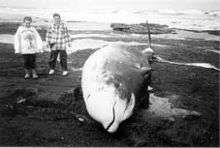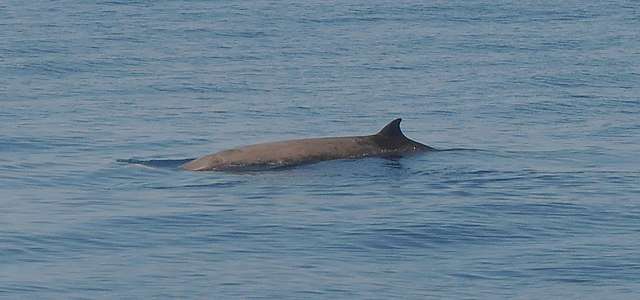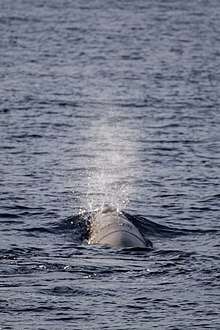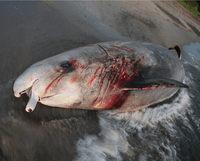Cuvier's beaked whale
Cuvier's beaked whale or the goose-beaked whale (Ziphius cavirostris), the only member of the genus Ziphius, is the most widely distributed of all the beaked whales.[3] It is one of the most frequently seen beached whales, despite preferring deep pelagic waters, usually deeper than 1,000 m (3,300 ft).[4]
| Cuvier's beaked whale | |
|---|---|
 | |
 | |
| Size compared to an average human | |
| Scientific classification | |
| Kingdom: | Animalia |
| Phylum: | Chordata |
| Class: | Mammalia |
| Order: | Artiodactyla |
| Infraorder: | Cetacea |
| Family: | Ziphiidae |
| Genus: | Ziphius Cuvier, 1823 [2] |
| Species: | Z. cavirostris |
| Binomial name | |
| Ziphius cavirostris | |
| Range of Cuvier's beaked whale | |
The species name comes from Greek xiphos, "sword", and Latin cavus, "hollow" and rostrum, "beak", referring to the indentation on the head in front of the blowhole.[5]
History of discovery
The French anatomist Georges Cuvier, in his treatise Sur les Ossements fossiles (1823),[6] first described the species based on an imperfect skull from the Mediterranean coast of France. It had been obtained by M. Raymond Gorsse in the department of Bouches-du-Rhône, near Fos, in 1804 from a local who had found it on the seashore the previous year. Cuvier named it Ziphius cavirostris, the specific name being derived from the Latin cavus for "hollow" or "concave", in reference to the deep hollow (the prenarial basin) in the skull, a diagnostic trait of the species. Cuvier believed it to represent the remains of an extinct species. Zoologists did not realize the extant nature of the species until 1850, when Paul Gervais compared the type specimen to another that had stranded itself at Aresquiès, Hérault, in May of the same year, and found the two to be identical.[7] There is no connection between Cuvier's beaked whale and the mythical Ziphius, or "Water-Owl", a creature in medieval folklore which had the characteristics of both an owl and a fish. Its dorsal fin was said to be sword-shaped, and pierced ship's hulls, while the beak was said to resemble an owl's head.[8]
Description

The body of Cuvier's beaked whale is robust and cigar-shaped, similar to those of other beaked whales, and can be difficult to distinguish from many of the mesoplodont whales at sea.[9] It grows to about 5–7 m (16–23 ft) in length and weighs 2,500 kg (5,500 lb).[5] No significant size difference is seen between sexes.[9]
Its dorsal fin is curved, small, and located two-thirds of the body length behind the head. Its flippers are equally small and narrow and can be tucked into pockets in the body wall, presumably to prevent drag while swimming. Like other beaked whales, its flukes are large and lack the medial notch found in all other cetaceans. The head is short with a small, poorly defined rostrum and a gently sloping melon. A pair of throat grooves allows the whale to expand this region when sucking in its prey.[9]
Cuvier's beaked whale has a short beak in comparison with other species in its family, with a slightly bulbous melon, which is white or creamy in color, and a white strip runs back to the dorsal fin about two-thirds of the way along the back. The rest of the body color varies by individual: some are dark grey; others are a reddish brown. Individuals commonly have white scars and patches caused by cookiecutter sharks. The dorsal fin varies in shape from triangular to highly falcate, whilst the fluke is about one-quarter the body length. They live for around 40 years.
Diving adaptations
Food and foraging


Cuvier's beaked whales feed on several species of squid, including those in the families Cranchiidae, Onychoteuthidae, Brachioteuthidae, Enoploteuthidae, Octopoteuthidae, and Histioteuthidae; they also prey on deep-sea fish.[10] In 2014, scientists reported that they had used satellite-linked tags to track Cuvier's beaked whales off the coast of California, and found the animals dived up to 2,992 m (9,816 feet) below the ocean surface and spent up to two hours and 17 and a half minutes underwater before resurfacing, which represent both the deepest and the longest dives ever documented for any mammal.[11][12][13][14]
Range and habitat
Cuvier's has a cosmopolitan distribution in deep, offshore waters from the tropics to the cool, temperate seas. In the North Pacific, it occurs as far north as the Aleutians and in the North Atlantic as far north as Atlantic Canada in the west to Shetland in the east. In the Southern Hemisphere, it occurs as far south as Tierra del Fuego, South Africa, southern Australia, New Zealand, and the Chatham Islands. It also frequents such inland bodies of waters as the Gulfs of Mexico and likely the Caribbean and Mediterranean Seas.[15] The Mediterranean population is genetically distinct from North Atlantic population(s).[16]
Cuvier's beaked whale may be one of the most common and abundant of the beaked whales, with a worldwide population likely well over 100,000. An estimated 80,000 are in the eastern tropical Pacific, nearly 1,900 are off the west coast of the United States (excluding Alaska), and more than 15,000 are off Hawaii.[17]
In 2011, a tagged Cuvier's beaked whale dove to 2,992 m,[11] (9,816 ft) which is the deepest recorded dive by any mammal.[18][19] The whales' rib cages can fold down so as to reduce air pockets and decrease buoyancy.[20]
Conservation
Japanese whalers in the past opportunistically caught Cuvier's, taking between three and 35 each year (before 1955).[17] The species has been reported taken incidentally in fisheries in Colombia, the Italian swordfish fishery, and in the drift gillnet fishery off the U.S. west coast, where between 22 and 44 individuals died each year off California and Oregon from 1992 to 1995.[17] Cuvier's beaked whale is covered by the Agreement on the Conservation of Small Cetaceans of the Baltic, North East Atlantic, Irish and North Seas (ASCOBANS)[21] and the Agreement on the Conservation of Cetaceans in the Black Sea, Mediterranean Sea and Contiguous Atlantic Area (ACCOBAMS).[22] The species is further included in the Memorandum of Understanding Concerning the Conservation of the Manatee and Small Cetaceans of Western Africa and Macaronesia (Western African Aquatic Mammals MoU)[23] and the Memorandum of Understanding for the Conservation of Cetaceans and Their Habitats in the Pacific Islands Region (Pacific Cetaceans MoU).[24]
Beaked whales may also be sensitive to noise: a higher incidence of strandings has been recorded in noisy seas such as the Mediterranean, and multiple mass strandings have occurred following operations by the Spanish Navy in the Canary Islands.[25][26] In 2019, a review of evidence on the mass strandings of beaked whale linked to naval exercises where sonar was used was published. It concluded that the effects of mid-frequency active sonar are strongest on Cuvier's beaked whales but vary among individuals or populations, and the strength of the whales' response may depend on whether the individuals had prior exposure to sonar. The report considered that the most plausible explanation of the symptoms of decompression sickness such as gas embolism found in stranded whales to be the whales' response to sonar. It noted that no more mass strandings had occurred in the Canary Islands once naval exercises where sonar was used were banned there, and recommended that the ban be extended to other areas such as the Mediterranean where mass strandings continue to occur.[27][28]
Taxonomy
Its nearest relative, the only other living member of the subfamily Ziphiinae, is Shepherd's beaked whale (Tasmacetus sheperdi).
See also
References
- "Ziphius cavirostris Cuvier 1824 (Cuvier's beaked whale)". PBDB.
- William Perrin (2014). Perrin WF (ed.). "Ziphius Cuvier, 1823". World Cetacea Database. World Register of Marine Species. Retrieved 16 March 2015.
- Grzimek, Bernhard (2003). Hutchins, Michael; Kleiman, Devra G.; Geist, Valerius; et al. (eds.). Grzimek's Animal Life Encyclopedia, Vol 15, Mammals IV (2nd ed.). Farmington Hills, MI: Gale Group. ISBN 0-7876-5362-4.CS1 maint: ref=harv (link)
- "Cuvier's Beaked Whale (Ziphius cavirostris)". NOAA. 15 January 2015. Archived from the original on 30 March 2017. Retrieved 29 March 2017.CS1 maint: ref=harv (link)
- "Cuvier's Beaked Whales, Ziphius cavirostris". MarineBio Conservation Society. 2013. Archived from the original on 18 August 2013. Retrieved 3 February 2013.
- Cuvier, Georges (1823). Recherches sur les ossemens fossiles (in French). 5.1 (2nd ed.). Paris. pp. 350–2, fig. 7. Retrieved 3 February 2013.CS1 maint: ref=harv (link)
- Turner, W (1872). "On the occurrence of Ziphius cavirostris in the Shetland Seas, and a comparison of its skull with that of Sowerby's whale (Mesoplodon Sowerbyi)". Transactions of the Royal Society of Edinburgh. Edinburgh. 26 (4): 759–80. doi:10.1017/s0080456800025618. OCLC 26145032.CS1 maint: ref=harv (link)
- Naish, Darren. (2014). Book Review: Sea Monsters on Medieval and Renaissance Maps. Tetrapod Zoology.
- Heyning, John E (2002). "Cuvier's Beaked Whale". In Jefferson, Thomas A (ed.). Encyclopedia of Marine Mammals. Academic Press. pp. 305–7. ISBN 0-12-551340-2.CS1 maint: ref=harv (link)
- Evans, Peter GH (1987). The Natural History of Whales and Dolphins. New York: Facts on File Publications. ISBN 0816017328. OCLC 14271801.CS1 maint: ref=harv (link)
- Gregory S. Schorr; Erin A. Falcone; David J. Moretti; Russel D. Andrews (2014). "First long-term behavioral records from Cuvier's beaked whales (Ziphius cavirostris) reveal record-breaking dives". PLOS ONE. 9 (3): e92633. doi:10.1371/journal.pone.0092633. PMC 3966784. PMID 24670984.
- Lee, Jane J. (2014-03-26). "Elusive Whales Set New Record for Depth and Length of Dives Among Mammals". National Geographic. Archived from the original on 2014-03-29.
- "How low can you go? This whale is the champion of deep diving". March 26, 2014 – via in.reuters.com.
- "The Globe and Mail".
- Reeves, Randall R; Stewart, Brent S; Clapham, Phillip J; Powell, James A (2002). National Audubon Society Guide to Marine Mammals of the World. Alfred A. Knopf. p. 254. ISBN 0375411410.CS1 maint: ref=harv (link)
- D. Holcer D.. Fortuna M.C.. Mackelworth C. P.. 2014. Status and Conservation of Cetaceans in the Adriatic Sea (pdf). United Nations Environment Programme. Mediterranean Action Plan. Regional Activity Centre for Specially Protected Areas. Retrieved on September 04, 2017
- Taylor, B. L.; Baird, R.; Barlow, J.; Dawson, S. M.; et al. (2008). "Ziphius cavirostris". IUCN Red List of Threatened Species. 2008. Retrieved 3 February 2013.CS1 maint: ref=harv (link)
- "The depth of the problem". Washington Post.
- "Elusive Whales Set New Record for Depth and Length of Dives Among Mammals". National Geographic News. March 26, 2014.
- Palmer, Jane (15 January 2015). "Secrets of the animals that dive deep into the ocean". BBC Earth. Retrieved 16 January 2015.
- "ASCOBANS | Agreement on the Conservation of Small Cetaceans of the Baltic, North East Atlantic, Irish and North Seas". www.ascobans.org.
- "Accobams News".
- "Pacific Cetaceans - Convention on Migratory Species". Pacific Cetaceans.
- "Species | CMS". www.cms.int.
- "Lethal Sounds: The use of military sonar poses a deadly threat to whales and other marine mammals". NRDC. June 2006. Retrieved 3 February 2013.
- Faerber, Meghan M.; Baird, Robin W. (2010). "Does a lack of observed beaked whale strandings in military exercise areas mean no impacts have occurred? A comparison of stranding and detection probabilities in the Canary and main Hawaiian Islands" (PDF). Marine Mammal Science. 26 (3): 602–613. doi:10.1111/j.1748-7692.2010.00370.x. Retrieved 11 January 2014.
- Bernaldo de Quirós Y, Fernandez A, Baird RW, Brownell RL Jr, Aguilar de Soto N, Allen D, Arbelo M, Arregui M, Costidis A, Fahlman A, Frantzis A, Gulland FMD, Iñíguez M, Johnson M, Komnenou A, Koopman H, Pabst DA, Roe WD, Sierra E, Tejedor M, Schorr G. (30 January 2019). "Advances in research on the impacts of anti-submarine sonar on beaked whales". Proceedings of the Royal Society B. 286 (1895): 20182533. doi:10.1098/rspb.2018.2533. PMC 6364578. PMID 30963955.CS1 maint: uses authors parameter (link)
- Batchelor, Tom (30 January 2019). "Scientists demand military sonar ban to end mass whale strandings". The Independent.
Further reading
- Carwardine, Mark; Camm, Martin (2000). Whales, Dolphins and Porpoises. London: Dorling Kindersley. ISBN 0-7513-2781-6.CS1 maint: ref=harv (link)
External links
![]()
- Whale & Dolphin Conservation Society (WDCS)
- Cuvier's Beaked Whale - The Beaked Whale Resource
- Cuvier's Beaked Whale - ARKive bio
- MNZ MM002092, collected Cape Kidnappers, Hawkes Bay, New Zealand, 14 October 1988
- Voices of the Sea - Sounds of the Cuvier's beaked Whale


.jpg)